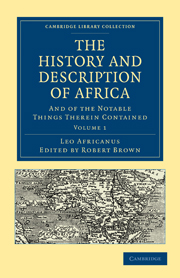Book contents
- Frontmatter
- Contents
- PREFATORY NOTE
- INTRODUCTION
- NORTHERN AFRICA
- BARBARY
- NORTHERN FEZ
- PORY'S MAP OF AFRICA (reduced)
- A GEOGRAPHICAL HISTORIE of AFRICA
- PORY'S DEDICATION TO SIR ROBERT CECIL
- HIS ADDRESS TO THE READER
- HIS GENERAL DESCRIPTION OF AFRICA
- HIS DESCRIPTION OF PLACES UNDESCRIBED BY LEO
- AN APPROBATION OF LEO'S HISTORY BY RICHARD HAKLUYT AND OTHERS
- Notes on Pory's Introductory Matter
- JOHN LEO HIS FIRST BOOK OF THE DESCRIPTION OF AFRICA
- Notes to Book I
JOHN LEO HIS FIRST BOOK OF THE DESCRIPTION OF AFRICA
Published online by Cambridge University Press: 05 October 2010
- Frontmatter
- Contents
- PREFATORY NOTE
- INTRODUCTION
- NORTHERN AFRICA
- BARBARY
- NORTHERN FEZ
- PORY'S MAP OF AFRICA (reduced)
- A GEOGRAPHICAL HISTORIE of AFRICA
- PORY'S DEDICATION TO SIR ROBERT CECIL
- HIS ADDRESS TO THE READER
- HIS GENERAL DESCRIPTION OF AFRICA
- HIS DESCRIPTION OF PLACES UNDESCRIBED BY LEO
- AN APPROBATION OF LEO'S HISTORY BY RICHARD HAKLUYT AND OTHERS
- Notes on Pory's Introductory Matter
- JOHN LEO HIS FIRST BOOK OF THE DESCRIPTION OF AFRICA
- Notes to Book I
Summary
Why this part of the worlde was named Africa
Africa is called in the Arabian toong Iphrichia, of the word Faraca, which signifieth in the said language, to diuide: but why it should be so called, there are two opinions; the first is this: namely, because this part of the worlde is diuided from Europa by the Mediterran sea, and from Asia by the it from riuer Nilus. Others are of opinion, that this name Africa was deriued from one Ifricus the king of Arabia Fœlix, who is saide to haue beene the first that euer inhabited these partes. This Ifricus waging warre against the king of Assyria, and being at length by him driuen out of his kingdome, passed with his whole aimie ouer Nilus, and so conducting his troupes westward, made no delay till he was come vnto the region lying about Carthage. Hence it is that the Arabians do imagine the countrie about Carthage onely, and the regions lying westward thereof, to comprehende all Africa.
The borders of Africa
Africa (if we may giue credite vnto the writers of that nation, being men of learning, and most skilful Cosmographers) beginneth southward at certaine riuers issuing foorth of a lake in the desert of Gaoga. Eastward it bordereth vpon the riuer Nilus. It extendeth northward to that part of Egypt, where Nilus at seuen mouthes dischargeth his streames into the Mediterran sea: from whence it stretcheth westward as farre as the streites of Gibraltar, and is bounded on that part with the vtmost sea-towne of all Libya, called Nun. Likewise the south part thereof abutteth vpon the Ocean sea, which compasseth Africa almost as farre as the deserts of Gaoga.
- Type
- Chapter
- Information
- The History and Description of AfricaAnd of the Notable Things Therein Contained, pp. 122 - 190Publisher: Cambridge University PressPrint publication year: 2010First published in: 1896



